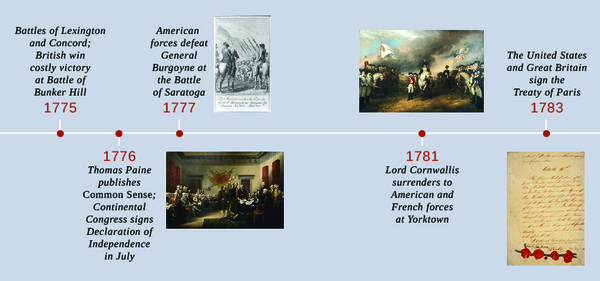| << Chapter < Page | Chapter >> Page > |

Great Britain pursued a policy of law and order when dealing with the crises in the colonies in the late 1760s and 1770s. Relations between the British and many American Patriots worsened over the decade, culminating in an unruly mob destroying a fortune in tea by dumping it into Boston Harbor in December 1773 as a protest against British tax laws. The harsh British response to this act in 1774, which included sending British troops to Boston and closing Boston Harbor, caused tensions and resentments to escalate further. The British tried to disarm the insurgents in Massachusetts by confiscating their weapons and ammunition and arresting the leaders of the patriotic movement. However, this effort faltered on April 19, when Massachusetts militias and British troops fired on each other as British troops marched to Lexington and Concord, an event immortalized by poet Ralph Waldo Emerson as the “shot heard round the world.” The American Revolution had begun.
The decade from 1763 to 1774 was a difficult one for the British Empire. Although Great Britain had defeated the French in the French and Indian War, the debt from that conflict remained a stubborn and seemingly unsolvable problem for both Great Britain and the colonies. Great Britain tried various methods of raising revenue on both sides of the Atlantic to manage the enormous debt, including instituting a tax on tea and other goods sold to the colonies by British companies, but many subjects resisted these taxes. In the colonies, Patriot groups like the Sons of Liberty led boycotts of British goods and took violent measures that stymied British officials.
Boston proved to be the epicenter of protest. In December 1773, a group of Patriots protested the Tea Act passed that year—which, among other provisions, gave the East India Company a monopoly on tea—by boarding British tea ships docked in Boston Harbor and dumping tea worth over $1 million (in current prices) into the water. The destruction of the tea radically escalated the crisis between Great Britain and the American colonies. When the Massachusetts Assembly refused to pay for the tea, Parliament enacted a series of laws called the Coercive Acts, which some colonists called the Intolerable Acts. Parliament designed these laws, which closed the port of Boston, limited the meetings of the colonial assembly, and disbanded all town meetings, to punish Massachusetts and bring the colony into line. However, many British Americans in other colonies were troubled and angered by Parliament’s response to Massachusetts. In September and October 1774, all the colonies except Georgia participated in the First Continental Congress in Philadelphia. The Congress advocated a boycott of all British goods and established the Continental Association to enforce local adherence to the boycott. The Association supplanted royal control and shaped resistance to Great Britain.

Notification Switch
Would you like to follow the 'U.s. history' conversation and receive update notifications?